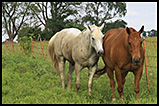Pet Articles
RAO in Pet Horses

One of the more common problems affecting horses is a condition known as Recurrent Airway Obstruction (RAO); it can also be referred to as heaves or COPD (chronic obstructive pulmonary disease). This is a respiratory disease that is characterized by coughing, increased rate and effort of breathing, and often, nasal discharge. Severely affected horses can also have what is known as a “heaves line” – this is a visible line on the horse’s side, between the lungs and the abdomen, caused by the increased effort of the abdominal muscles to help with breathing; the line is really the increased definition of those abdominal muscles. Other than the respiratory difficulties, horses are otherwise normal. There does not seem to be a breed or gender preference, although older horses are more commonly affected.
While the exact cause of the disease is unknown, there is strong evidence that RAO is a hypersensitivity reaction to environmental allergens. Horses that are continuously exposed to dusts and moulds might develop an increased sensitivity to these substances, and will react more severely when they come in to contact with them compared to horses that are not hypersensitized. A big factor that contributes to this continuous exposure is stabling, as dusts and moulds are very common in both hays and straws. When a sensitized horse inhales these allergens, it results in an inflammatory reaction in the lungs, which results in an increased production of mucus and other inflammatory mediators. This build-up of substances in the lungs is what causes the coughing and breathing difficulties.
There are several different ways to test for RAO, but the best test so far is simply a good history taking on the part of your veterinarian. RAO is a disease that often disappears and reappears depending on the horse’s environment, so your vet will probably ask you questions about the occurrence of the clinical signs and whether or not they change when your horse is in the barn compared to when he or she is out on pasture. There are other factors that can contribute to the occurrence of RAO, but the environment is probably the most important.
There are two other tests that your veterinarian might consider:
- There first one is a bronchoalveolar lavage (BAL). This involves putting an endoscope down your horse’s trachea in order to get a sample of the lung fluid. Analyzing the lung fluid is helpful because it can help differentiate between an infection of the airways, compared to other non-inflammatory respiratory diseases. Your horse would be sedated for this procedure.
- Another option is allergy testing. While still in the preliminary stages, allergy testing is one way to determine which allergens your horse may be reacting to (while the actual test is different, this is the same principle as for allergy testing in humans). While dusts and moulds are the most common triggers, keep in mind that there are many different types of each, as well as a host of other allergens that may be causing the horse to react. By being able to identify those allergens, they can then be removed from the horse’s environment.
The best treatment for RAO is environmental management. If your horse tends to get worse when stabled, try to increase the time he or she spends outdoors. Removing your horse from the environmental stimuli that are causing them to react is the simplest (and cheapest) way to avoid re-occurrence of the clinical signs. If you have to keep your horse stabled, consider changing the bedding more frequently, and also consider wetting down the hay before you feed it, as water can help to reduce the amount of dust and mould floating around while your horse has its head buried in its feed. However, there are some cases when the clinical signs can’t be managed by environmental changes alone, and pharmaceutical treatments may be required. If your horse is having a severe reaction, bronchodilators can be used in the short-term to help open up the airways and decrease breathing resistance. For severely affected horses, a long-term solution is to administer steroids in order to reduce the inflammation occurring in the lungs.
Although not curable, RAO is a very manageable disease, especially if proper attention is paid to the horse, its environment and its surroundings.
